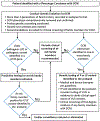Considering complexity in the genetic evaluation of dilated cardiomyopathy
- PMID: 33109712
- PMCID: PMC8283773
- DOI: 10.1136/heartjnl-2020-316658
Considering complexity in the genetic evaluation of dilated cardiomyopathy
Abstract
Dilated cardiomyopathy (DCM) is a cardiovascular disease of genetic aetiology that causes substantial morbidity and mortality, and presents considerable opportunity for disease mitigation and prevention in those at risk. Foundational to the process of caring for patients diagnosed with DCM is a clinical genetic evaluation, which always begins with a comprehensive family history and clinical evaluation. Genetic testing of the proband, the first patient identified in a family with DCM, within the context of genetic counselling is always indicated, regardless of whether the DCM is familial or non-familial. Clinical screening of at-risk family members is also indicated, as is cascade genetic testing for actionable variants found at genetic testing in the proband. Clinicians now have expansive panels with many genes available for DCM genetic testing, and the approaches used to evaluate rare variants to decide which are disease-causing continues to rapidly evolve. Despite these recent advances, only a minority of cases yield actionable variants, even in familial DCM where a genetic aetiology is highly likely. This underscores that our knowledge of DCM clinical genetics remains incomplete, including variant interpretation and DCM genetic architecture. Emerging data suggest that the single-variant Mendelian disease model is insufficient to explain some DCM cases, and rather that multiple variants, both common and rare, and at times key environmental factors, interact to cause DCM. A simple model illustrating the intersection of DCM genetic architecture with environmental impact is provided.
Keywords: genetics; idiopathic dilated cardiomyopathy.
© Author(s) (or their employer(s)) 2021. No commercial re-use. See rights and permissions. Published by BMJ.
Conflict of interest statement
Competing interests: None declared.
Figures




References
-
- Centers for Disease Control and Prevention. National Center for Health Statistics: Leading Causes of Death. https://www.cdc.gov/nchs/fastats/leading-causes-of-death.htm. Published 2017. Accessed 6/22/2020, 2020.
-
- Hershberger RE, Hedges DJ, Morales A. Dilated cardiomyopathy: the complexity of a diverse genetic architecture. Nat Rev Cardiol 2013;10:531–547. - PubMed
-
- Burkett EL, Hershberger RE. Clinical and genetic issues in familial dilated cardiomyopathy. J Am Coll Cardiol 2005;45:969–981. - PubMed
-
- Haas J, Frese KS, Peil B, et al. Atlas of the clinical genetics of human dilated cardiomyopathy. Eur Heart J 2015;36:1123–1135a. - PubMed
Publication types
MeSH terms
Grants and funding
LinkOut - more resources
Full Text Sources
Medical
